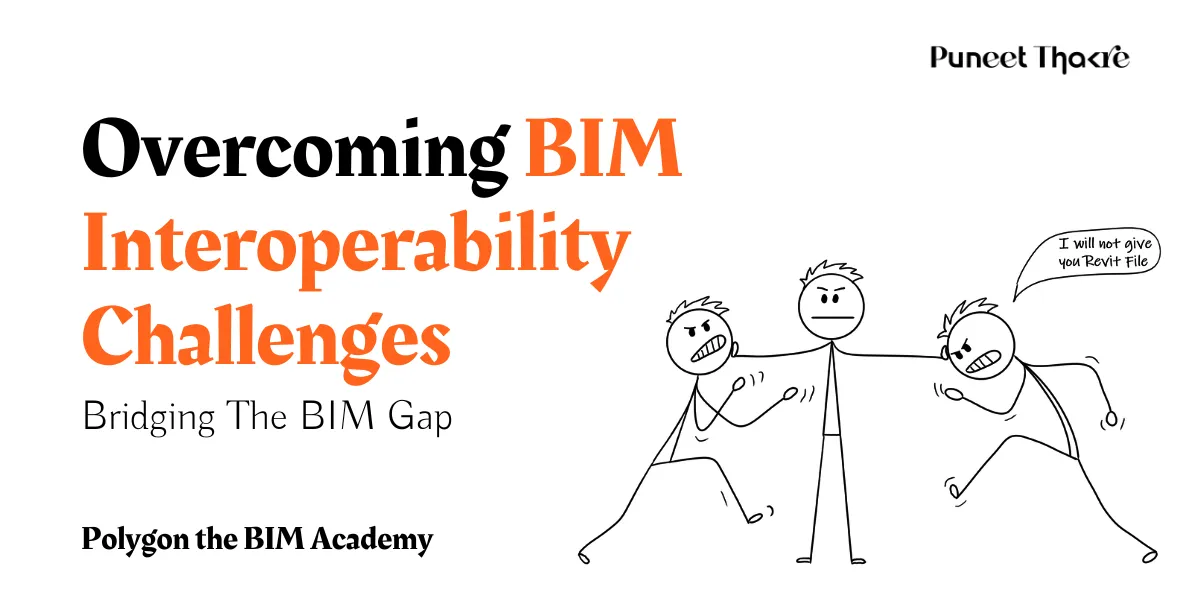#BIM Interoperability Challenges
Hello Architects & AEC Enthusiasts!
As we know the construction industry stands at the brink of a digital revolution, spearheaded by Building Information Modeling (BIM). As the spine of modern architectural, engineering, and construction (AEC) projects, BIM's ability to foster collaboration, improve efficiencies, and reduce costs is unparalleled. Yet, its potential is often hamstrung by interoperability challenges, a hurdle that many in the industry are striving to overcome. BIM's complex web of data formats, standards, and applications demands a solution that not only enhances collaborative efforts across different software platforms but also streamlines the construction lifecycle. In this article we'll delves into the top solutions for bridging the BIM gap, paving the way for a more interconnected and efficient future in construction.
Understanding the Complexity of BIM Interoperability in the Construction Industry
What is BIM interoperability and why is it crucial?
BIM interoperability refers to the ability of different BIM applications and tools to exchange information seamlessly. It's the cornerstone of a collaborative AEC environment, ensuring that a project's stakeholders can share and manipulate building information models effectively across different platforms. The essence of interoperability lies in its power to facilitate data exchange and integrate workflows, crucial for the lifecycle management of any construction project. When BIM tools are interoperable, they break down organizational silos, leading to improved efficiency, accuracy in structural design, and a reduction in time and costs associated with information mismanagement.
The role of BIM in facilitating information exchange across AEC stakeholders
BIM's role extends beyond mere modeling; it's a catalyst for profound information exchange among all stakeholders in the AEC industry. From architects and engineers to contractors and facility management teams, BIM serves as a unified platform that harnesses the collective intelligence of all parties. This synergy is pivotal for the lifecycle of a construction project, ensuring that data is not just shared but is also accurate and timely. The collaborative nature of BIM fosters a team-based approach to design and construction, streamlining processes and enhancing project delivery outcomes.
Common interoperability challenges faced in the construction industry
The path to achieving seamless interoperability is fraught with challenges. Divergent data formats, lack of standardization, and the use of different BIM software tools can lead to significant barriers in information exchange. These interoperability issues create gaps in data exchange and collaboration, resulting in delays, increased costs, and potential errors in the construction process. Moreover, the literature review highlights that the absence of universally accepted BIM standards further amplifies these challenges, making it difficult for stakeholders to integrate BIM processes effectively throughout the construction project lifecycle.
Exploring the Role of Data Formats and Standards in BIM Interoperability
The significance of Industry Foundation Classes (IFC) and data format in BIM
Industry Foundation Classes (IFC) represent a critical element in the quest for BIM interoperability. Designed as a neutral data format, IFC facilitates the open exchange of building information models, enabling different software applications to understand and use BIM data effectively. This standardization is the backbone of interoperable BIM, ensuring that all stakeholders in a construction project can access, share, and manipulate BIM models regardless of the BIM software they use. The universal adoption of IFC and other standardized data formats paves the way for a seamless collaborative environment, essential for the efficient management and completion of construction projects.
How standardization influences BIM adoption and interoperability
Standardization plays a pivotal role in enhancing BIM adoption and interoperability across the AEC industry. By establishing common data formats and standards, such as IFC, stakeholders can ensure consistent and error-free exchange of BIM information. This uniformity is crucial for the seamless integration of BIM tools and processes, facilitating effective collaboration among diverse project teams. Moreover, standardization fosters a level playing field, where small and large organizations alike can benefit from BIM's transformative potential. Adopting standardized BIM protocols can also lead to significant improvements in project delivery, including better quality control, cost reductions, and accelerated timelines.
The impact of differing BIM data schemas on project delivery
Varying BIM data schemas present a substantial hurdle to project delivery in the AEC sector. Differences in how BIM applications structure and interpret data can lead to inconsistencies, miscommunication, and errors across the project lifecycle. The absence of a unified data schema complicates the process of information exchange, requiring extensive manual effort to reconcile data and ensure that it remains accurate and useful. This fragmentation hinders the BIM implementation process, delaying projects and inflating costs. To overcome these challenges, the industry is increasingly focusing on the development and adoption of universal data schemas that promote interoperability and facilitate smoother, more efficient project delivery.
Compatibility among 3D design and Building Information Modeling (BIM) applications.
Rhino & Revit
Rhino and Revit represent two powerhouse applications in the realm of architectural design and BIM. While Rhino excels in complex surface modeling and computer-aided design, Revit is renowned for its BIM capabilities, particularly in detailing, documentation, and construction management. The challenge lies in the interoperability between these two platforms, which is crucial for projects that require the strengths of both. Developers have worked tirelessly to enhance the compatibility between Rhino and Revit, enabling smoother data exchange and integration. This bridging of capabilities allows architects and designers to leverage the best of both worlds, resulting in more innovative and efficient design and construction processes.
Rhino Inside Revit
"Rhino Inside Revit" is a groundbreaking development that dramatically enhances the interoperability between these two applications. This plugin essentially embeds Rhino's powerful 3D modeling capabilities directly into the Revit environment, allowing users to access Rhino’s extensive toolset without leaving the Revit application. This integration facilitates an unprecedented level of collaboration and efficiency in the design and construction process, making it easier for stakeholders to iteratively refine designs and accurately translate them into BIM models. The advent of Rhino Inside Revit represents a significant step forward in bridging the gap between freeform design and BIM, streamlining project workflows and improving outcomes.
SketchUp & Revit
SketchUp and Revit are other critical players in the architectural design and BIM domains, respectively. SketchUp is widely appreciated for its user-friendly interface and intuitive design capabilities, making it a favorite among early-stage design professionals. On the other hand, Revit is tailored for BIM, excelling in detailed modeling, coordination, and construction documentation. The integration of SketchUp and Revit is vital for a seamless design to construction workflow, allowing ideas conceptualized in SketchUp to be easily imported and developed within the Revit BIM environment. Efforts to enhance interoperability between these platforms are ongoing, with the aim of facilitating a more fluid exchange of information and collaborative design process across different project phases.
Strategies to Enhance BIM Interoperability in Engineering and Construction
Integrating BIM tools for a collaborative design and construction process
Integrating BIM tools across the construction project lifecycle is essential for unlocking the full potential of collaboration. Such integration enables stakeholders to access and use the same BIM models and data, fostering a unified approach to project management, design, and construction. By leveraging interoperable BIM tools, project teams can streamline communication, reduce errors, and ensure that all project elements are accurately coordinated. This approach not only enhances project delivery but also paves the way for more efficient and sustainable construction practices. Overcoming the interoperability challenges between different BIM applications is key to achieving a fully collaborative and efficient construction process.
Fostering interoperable BIM processes through stakeholder engagement
Engaging all stakeholders in the adoption and use of interoperable BIM processes is crucial for overcoming the challenges of BIM implementation. By involving architects, engineers, contractors, and facility managers in the early stages of BIM planning and execution, it becomes possible to identify and address interoperability issues proactively. Stakeholder engagement ensures that all parties understand the benefits of BIM, leading to greater commitment and more effective use of BIM throughout the project lifecycle. This collective effort not only enhances the overall project outcomes but also fosters a culture of innovation and continuous improvement within the AEC industry.
Overcoming software interoperability issues for a seamless BIM implementation
Addressing software interoperability issues is crucial for a seamless BIM implementation. To overcome these challenges, project teams must focus on selecting BIM tools and applications that emphasize interoperability. This may involve adopting industry-standard software that supports open data formats, such as IFC, to ensure consistent and reliable data exchange. Additionally, leveraging integrations and plugins that enhance the compatibility between different BIM applications can greatly reduce barriers to interoperability. By prioritizing software and tools that support a collaborative BIM environment, projects can achieve more streamlined workflows, reduce information silos, and improve overall project efficiency and accuracy.
Futuristic Insights: The Road Ahead for BIM Interoperability
Emerging technologies enhancing BIM interoperability in AEC
Emerging technologies hold the key to solving many of the interoperability challenges currently faced by the AEC industry. Innovations such as artificial intelligence (AI) and machine learning are being harnessed to improve the semantic understanding and integration of BIM data across different platforms. These technologies can automatically detect and rectify inconsistencies in BIM models, facilitating a more efficient data exchange process. Additionally, the rise of cloud-based BIM platforms enables real-time collaboration and access to BIM models from anywhere, further enhancing interoperability. As these technologies continue to evolve, they promise to significantly improve the efficiency and effectiveness of BIM interoperability.
The role of AI and machine learning in solving interoperability issues
The application of AI and machine learning in tackling BIM interoperability issues is becoming increasingly prevalent. These technologies offer sophisticated algorithms that can analyze complex BIM data, identify patterns, and predict potential issues before they become problematic. By automating the process of data validation and correction, AI and machine learning make it feasible to achieve higher levels of accuracy and consistency in BIM models, regardless of the software used. This not only streamlines the data exchange process but also minimizes errors and redundancies, leading to better project outcomes. The integration of AI and machine learning into BIM practices is poised to revolutionize the way the AEC industry handles interoperability challenges.
Predictions for the future landscape of BIM in the construction industry
The future landscape of BIM in the construction industry is set to be characterized by even greater connectivity and collaboration. As interoperability challenges are systematically addressed, we can expect a more seamless integration of BIM tools and processes across all project phases. This will facilitate a truly collaborative environment, where information flows freely and efficiently between stakeholders, leading to even higher levels of efficiency and innovation in project delivery. Furthermore, the continued evolution of standards and the adoption of emerging technologies will further solidify BIM’s role as the foundation of modern construction management. The trajectory of BIM interoperability points towards a future where the full potential of digital transformation in the AEC industry can be realized.
Now, I’d love to hear from you! Have you faced BIM interoperability challenges in your projects? What solutions have you found effective? Let's keep the conversation going in the comments below. After all, the more we share, the more we learn and grow together. And who knows? Together, we might just bake the perfect project.





